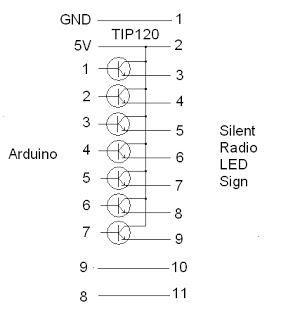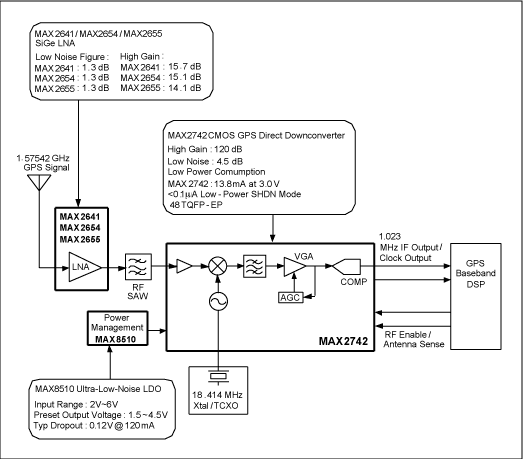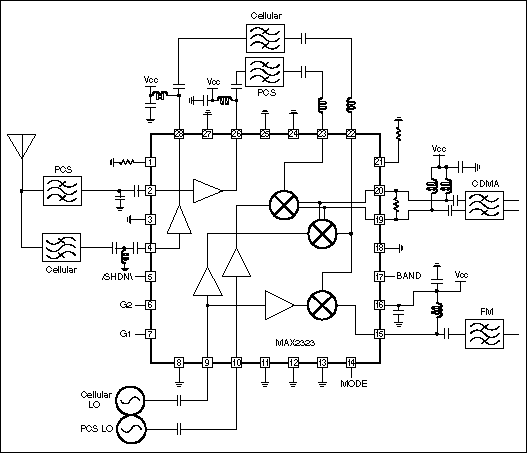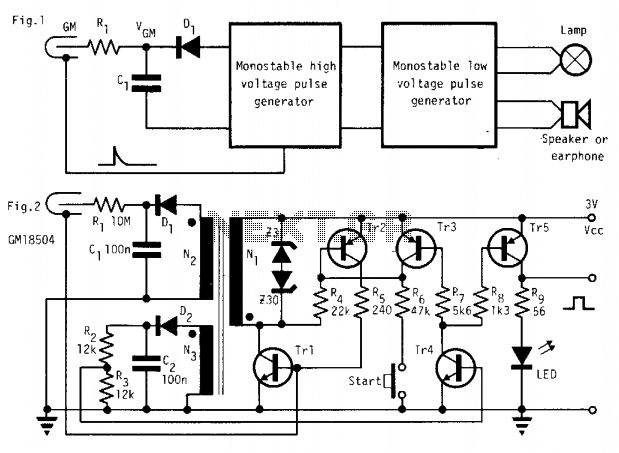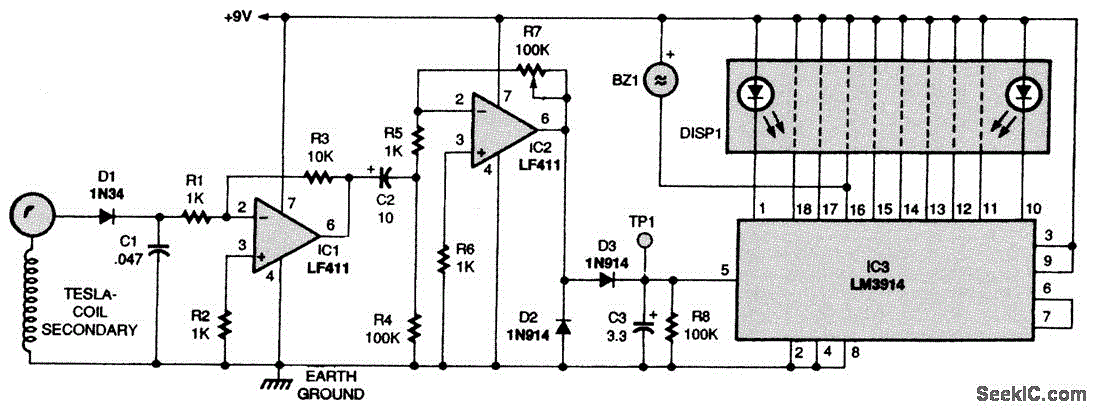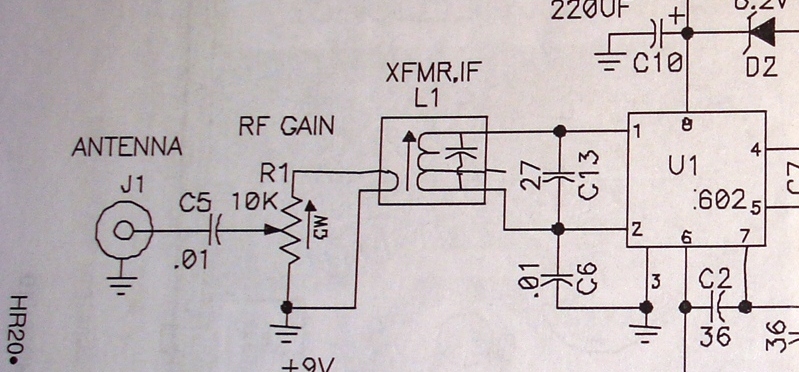
W3HWJ Radio Receiver Projects
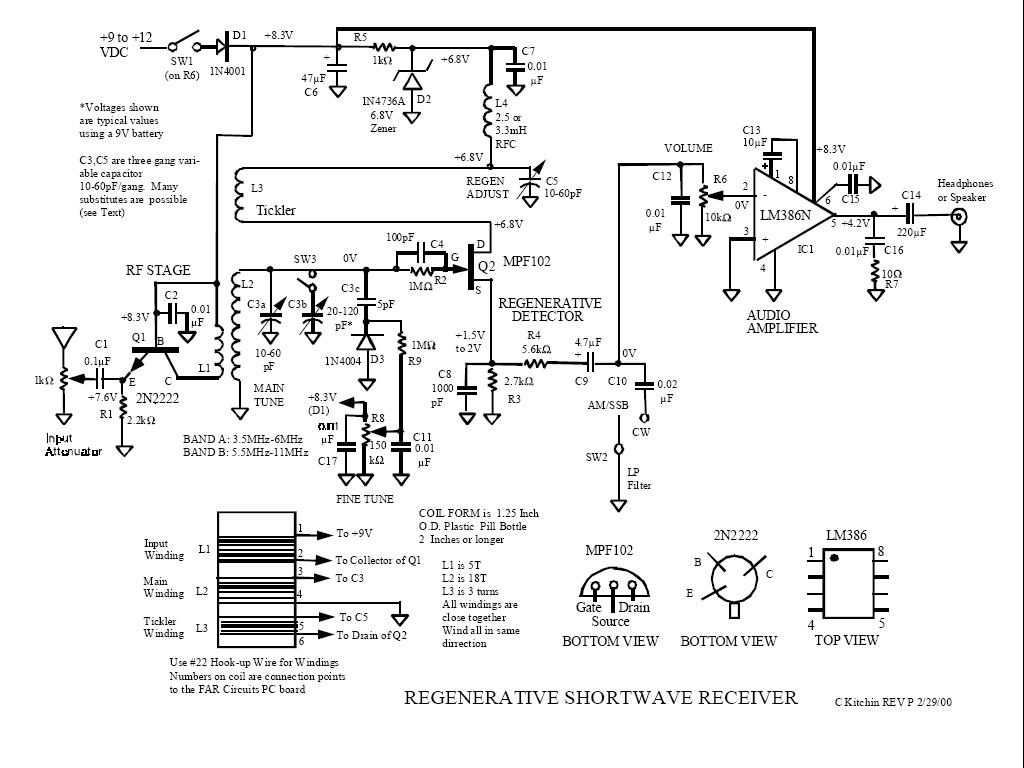
The logical first choice was to start with simple regenerative circuits, utilizing one or two transistors and possibly a basic audio amplifier with a single integrated circuit. A few simple tube radios purchased at flea markets will delay any tube projects for the time being. Charles Kitchin has authored numerous articles about regenerative radios for QST and other hobby magazines. His design approach has proven effective, leading to successful implementations of his circuits. The initial attempt at a "Kitchin" design involved a printed circuit board sourced from Far Circuits, serving as an excellent learning tool that encouraged further experimentation and design modifications. A metal container originally used for Christmas cookies was repurposed to house the project. After drilling mounting holes for the controls, a matte finish was achieved using steel wool, followed by cleaning with mineral spirits and spray painting. Control labels were created with a Brother P-touch labeler, which produces attractive, durable, and well-adhered laminated labels. By changing the plug-in coil, coverage spans from 3.5 to over 10 MHz. Although copying SSB signals is challenging due to detector instability, it remains functional. Some design errors were made, such as mounting the speaker on the side of the case instead of the front or top cover to direct sound towards the listener. Additionally, a large value main tuning capacitor caused issues, despite the use of an 8:1 reduction dial, making the vari-cap "fine tuning" essential for successful SSB reception. Designing and fabricating a custom PCB is both challenging and educational, involving ExpressPCB software, blue Press 'n Peel transfer film, and etching boards with peroxide and muriatic acid. It was noted that Brother laser printer toner is less effective than HP toner for creating etching masks with Press 'n Peel film. PVC plumbing pipe and fittings serve as effective coil forms when combined with bases salvaged from defective radio tubes. This design utilizes a 6-pin tube base, which can often be found at ham swap meets for a nominal fee. A simple 3-pin integrated circuit, invented by Ferranti in the UK approximately four decades ago, is designed for very basic AM radios typically produced in locations like Hong Kong. It operates on a single 1.5V battery with minimal external components. Remarkably, it can receive KCBS (740 KHz) from San Francisco (60 miles away) without requiring an external antenna. However, interference from KSRO, located about 3 miles away on 1350 KHz, significantly impacts reception. The circuit demonstrates high sensitivity but limited selectivity. An innovative modification involved replacing the variable 47K resistor with an LED functioning as a voltage regulator, maintaining pin 1 at approximately 1.7 volts. It was later discovered that a lower voltage of 1.2 volts would yield better performance.
This project illustrates the fundamentals of regenerative radio design, emphasizing the importance of component selection and layout in achieving optimal performance. The use of a simple integrated circuit allows for a compact and efficient design, while the innovative use of an LED as a voltage regulator showcases creative problem-solving in circuit design. The challenges faced in this project, such as interference and tuning difficulties, highlight the need for careful consideration of circuit parameters and environmental factors in radio communications. The learning experience gained from PCB design and construction further enhances the understanding of electronic circuit design principles, making this a valuable endeavor for both hobbyists and professionals in the field. The attention to detail in housing the project and labeling controls also reflects best practices in electronic design, contributing to user-friendly interfaces and overall project aesthetics.The logical first choice was to start out with simple regenerative circuits. Just one or two transistors and maybe a simple audio amplifier using one integrated circuit. I already have a few simple tube radios that I bought at flea markets, so I will defer any tube projects for a while yet. Charles Kitchin has written many articles about regen radios for QST and other hobby magazines. I like his approach to design and have had good luck with his circuits. The first attempt at a "Kitchin" used a printed circuit board that I bought from Far Circuits. This was an excellent learning tool and prompted me to continue experimenting and changing the design and the circuit board. To house this project, I "re-purposed" a metal container that originally contained Christmas cookies.
After drilling the mounting holes for all the controls, I used a bit of steel wool to create a matte finish, cleaned with mineral spirits, and then spray painted. The labels for the controls were made with a Brother P-touch labeler. Thanks to Dave Schmarder, N2DS, for getting me interested in the Brother. It makes a nice laminated label that is good-looking, sturdy, and solidly adherent. By changing the plug-in coil, I can cover 3. 5 to over 10 MHz. It`s a bit difficult to copy SSB signals as the detector is not super stable, but it works well enough!
I made a few mistakes in this version, such as mounting the speaker on the side of the case. It needs to be on the front or the top cover to direct sound toward the listener. Also, using a large value main tuning capacitor proved to be a problem, even though I used an 8:1 reduction dial. The vari-cap "fine tuning" is definitely needed to copy SSB successfully! Designing and making your own pc board is challenging and educational. I learned about ExpressPCB software, blue Press `n Peel transfer film, and using peroxide and muriatic acid to etch boards.
I also found that the toner used by Brother laser printers doesn`t work as well as HP toner for making etching masks using Press `n Peel film. PVC plumbing pipe and fittings make good coil forms when used in conjunction with bases salvaged from defective radio tubes.
This design uses a 6-pin tube base. At most ham swap meets, I can buy dead 6-pin tubes for 25 cents. This simple 3-pin integrated circuit has always been interesting to me. Invented by Ferranti in the UK about 4 decades ago, it was aimed at very simple AM radios that were made in places like Hong Kong. It uses only a single 1. 5V battery and a minimum of external components. With a minimum number of parts, I was amazed that I could receive KCBS (740 KHz. ) from San Francisco (60 miles) without any external antenna. My chief problem was that KSRO, about 3 miles away on 1350 KHz. , came blasting through and covered half the available band! The circuit is sensitive, but not very selective. My interesting innovation for this circuit was to replace the variable 47K resistor with an LED used as a voltage regulator.
The forward voltage of the LED keeps pin 1 at about 1. 7 Volts. I later learned that this is a bit high and 1. 2 Volts will work better. 🔗 External reference
This project illustrates the fundamentals of regenerative radio design, emphasizing the importance of component selection and layout in achieving optimal performance. The use of a simple integrated circuit allows for a compact and efficient design, while the innovative use of an LED as a voltage regulator showcases creative problem-solving in circuit design. The challenges faced in this project, such as interference and tuning difficulties, highlight the need for careful consideration of circuit parameters and environmental factors in radio communications. The learning experience gained from PCB design and construction further enhances the understanding of electronic circuit design principles, making this a valuable endeavor for both hobbyists and professionals in the field. The attention to detail in housing the project and labeling controls also reflects best practices in electronic design, contributing to user-friendly interfaces and overall project aesthetics.The logical first choice was to start out with simple regenerative circuits. Just one or two transistors and maybe a simple audio amplifier using one integrated circuit. I already have a few simple tube radios that I bought at flea markets, so I will defer any tube projects for a while yet. Charles Kitchin has written many articles about regen radios for QST and other hobby magazines. I like his approach to design and have had good luck with his circuits. The first attempt at a "Kitchin" used a printed circuit board that I bought from Far Circuits. This was an excellent learning tool and prompted me to continue experimenting and changing the design and the circuit board. To house this project, I "re-purposed" a metal container that originally contained Christmas cookies.
After drilling the mounting holes for all the controls, I used a bit of steel wool to create a matte finish, cleaned with mineral spirits, and then spray painted. The labels for the controls were made with a Brother P-touch labeler. Thanks to Dave Schmarder, N2DS, for getting me interested in the Brother. It makes a nice laminated label that is good-looking, sturdy, and solidly adherent. By changing the plug-in coil, I can cover 3. 5 to over 10 MHz. It`s a bit difficult to copy SSB signals as the detector is not super stable, but it works well enough!
I made a few mistakes in this version, such as mounting the speaker on the side of the case. It needs to be on the front or the top cover to direct sound toward the listener. Also, using a large value main tuning capacitor proved to be a problem, even though I used an 8:1 reduction dial. The vari-cap "fine tuning" is definitely needed to copy SSB successfully! Designing and making your own pc board is challenging and educational. I learned about ExpressPCB software, blue Press `n Peel transfer film, and using peroxide and muriatic acid to etch boards.
I also found that the toner used by Brother laser printers doesn`t work as well as HP toner for making etching masks using Press `n Peel film. PVC plumbing pipe and fittings make good coil forms when used in conjunction with bases salvaged from defective radio tubes.
This design uses a 6-pin tube base. At most ham swap meets, I can buy dead 6-pin tubes for 25 cents. This simple 3-pin integrated circuit has always been interesting to me. Invented by Ferranti in the UK about 4 decades ago, it was aimed at very simple AM radios that were made in places like Hong Kong. It uses only a single 1. 5V battery and a minimum of external components. With a minimum number of parts, I was amazed that I could receive KCBS (740 KHz. ) from San Francisco (60 miles) without any external antenna. My chief problem was that KSRO, about 3 miles away on 1350 KHz. , came blasting through and covered half the available band! The circuit is sensitive, but not very selective. My interesting innovation for this circuit was to replace the variable 47K resistor with an LED used as a voltage regulator.
The forward voltage of the LED keeps pin 1 at about 1. 7 Volts. I later learned that this is a bit high and 1. 2 Volts will work better. 🔗 External reference
